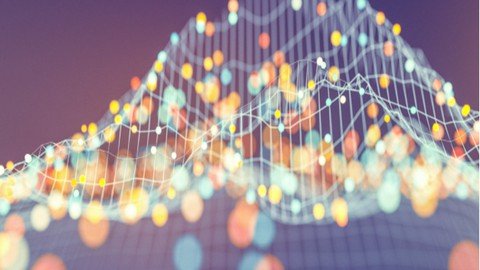Genre: eLearning | MP4 | Video: h264, 1280×720 | Audio: AAC, 44.1 KHz
Language: English | Size: 4.01 GB | Duration: 9h 3m
Data analysis (Python) for Electricity : Economics, Investments, Big Data (Click and Read below for discount codes)
What you’ll learn
Learn how to perform Data Engineering across ALL possible Energy Datasets
Learn the skills that will be required for the Green Energy Revolution, which is all about Data Science
Learn how to Implement Big Data methodologies for Energy Datasets
Learn how to apply Data Analysis for Energy Investments
Apply Data Analysis on Energy Storage, Electricity Generation and Demand
Requirements
We go through EVERY Python command, IN-DETAIL, Step by Step ! So you can start even with ZERO knowledge / experience in programming.
Description
The energy system is undergoing a transition, from fossil-fuels to renewable sources of energy.
This transition brings Data Science at the forefront, because renewable sources of energy are unpredictable, are installed massively across entire countries and lead to unprecedented new designs for the energy system.
Renewables have led to the development of new technologies that aim to facilitate the connection of renewables to the energy system.
Overall, the energy system is undergoing a fundamental , a radical transition, that has never been witnessed before.
Data Science is becoming an integral part of the new energy system that arises, because of the growing need for analysing the massive amount of data that arise. In this course we dive deep into key applications of data science to electricity systems.
Every video goes slowly and explains in-depth, every line of code that is used, in detail and with many examples. So , you will have no questions at all in the end of every video; you will not need to spend time trying to understand the code by yourself, because everything will have been explained clearly.
This course begins by applying data analysis to Electricity Demand datasets. We look at electricity profiles, of various frequencies. and we analyse them in depth.
Since datasets may come at different granularities (frequencies) we focus on transitioning from one set of granularity to another. This is fundamental because measurements from different locations may differ in terms of frequency, and a proper comparison of datasets would first involve bringing the datasets to a form where they will have the same granularity.
We then analyse datasets for energy storage; Energy Storage (e.g. batteries) are fundamental for the new energy system. They allow charging and discharging with electricity and as their costs are reducing they are gaining more and more presence in electricity systems, globally. Therefore, we look at Energy Storage datasets in detail.
We also look at datasets for electricity generation. From the calculation of patterns of generation, to the evaluation of the total installed capacity among others.
In addition, we present a Big Data Methodology; both in Excel and Python. When dealing with Big Data (i.e. very large datasets) it is important to be able to reduce the datasets sufficiently enough so that the key information is retained as much as possible. When reducing a large dataset, there is always a concern that the resulting, smaller, dataset will be radically different, which would mean that fundamental information will have been lost. The presented methodology ensures that when moving from a large dataset to a smaller one, the fundamental information is retained. Such methodology is being presented for an electricity dataset.
We also show how to present big data using Pivot Tables and Summary tables, using Python. This is an essential skill because Pivot Tables, can help with the understanding, presentation and interpretation of key aspects of datasets, in a very concise way.
Furthermore, we look into energy investment analysis, using Python. We identify mutually exclusive investments, we filter them and come up with a reduced investment set , so that the candidate investments are more easy to compare. This process facilitates and expedites the investment decision making process on energy projects.
In addition, we show how to update existing datasets, This happens very frequently, because in the process of conducting an energy study , key pieces of information may change and therefore, quick changes in the datasets need to be made.
Finally, we analyse electricity demand curves , such as the residual load duration curve , and interpret them in depth.
This is a MUST course for all those interested in understanding data science for electricity.
Who this course is for
Entrepreneurs
PhD students
Finance professionals working with Energy Datasets
Data Scientists / Analysts / Engineers working in the energy field
Software Engineers
Anyone interested to gain the Absolutely Necessary skills for getting a job in the field of Energy (energy transition, sustainability, climate change etc)
Homepage
https://www.udemy.com/course/data-engineering-for-electrical-energy-systems/
DOWNLOAD FROM HOT4SHARE.COM
DOWNLOAD FROM HOT4SHARE.COM
DOWNLOAD FROM HOT4SHARE.COM
DOWNLOAD FROM HOT4SHARE.COM
DOWNLOAD FROM HOT4SHARE.COM
DOWNLOAD FROM UPLOADGIG.COM
DOWNLOAD FROM UPLOADGIG.COM
DOWNLOAD FROM UPLOADGIG.COM
DOWNLOAD FROM UPLOADGIG.COM
DOWNLOAD FROM UPLOADGIG.COM
DOWNLOAD FROM RAPIDGATOR.NET
DOWNLOAD FROM RAPIDGATOR.NET
DOWNLOAD FROM RAPIDGATOR.NET
DOWNLOAD FROM RAPIDGATOR.NET
DOWNLOAD FROM RAPIDGATOR.NET
DOWNLOAD FROM NITROFLARE.COM
DOWNLOAD FROM NITROFLARE.COM
DOWNLOAD FROM NITROFLARE.COM
DOWNLOAD FROM NITROFLARE.COM
DOWNLOAD FROM NITROFLARE.COM




